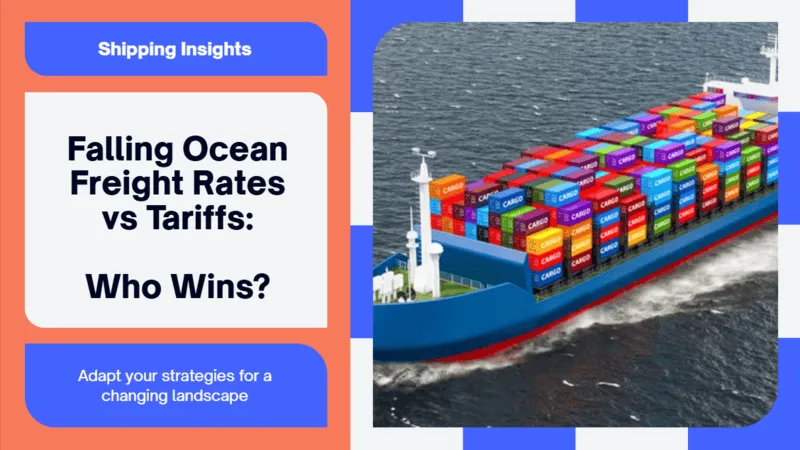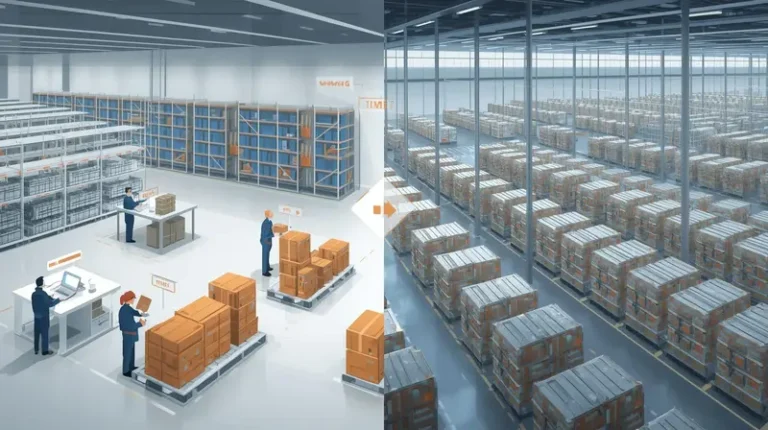Ocean Freight Trends: Can Falling Rates Offset Tariff Costs? A Strategic Playbook for Brands

Last updated on August 15, 2025

In this article
 10 minutes
10 minutes
- Ocean Freight Trends: The Data Speaks
- Why Sellers Should Be Paying Attention (But Few Are)
- Link to the Tariff Pause, and Why It Matters
- How to Act: Your Tactical Playbook
- What to Look for When Choosing Fulfillment Partners Now
- Now vs. Later, You Don’t Get a Mulligan in Q4
- Bringing It Home
- Frequently Asked Questions
Spot ocean freight rates just tumbled more than 50% in 2025. Sounds like a rare win, right? But paired with stubborn tariffs and uneven demand, that dip is a double-edged sword. Recent developments in ocean freight trends, such as shifting capacity and changing rate structures, have contributed to the current market situation and are shaping how businesses should respond. As someone watching orders flow through fulfillment centers every week, I can’t help but think many sellers aren’t fully connecting the dots. This is the time to reconsider your cost structure, not coast through Q4 waiting for luck.
Ocean Freight Trends: The Data Speaks
Let’s look at the numbers. Asia–U.S. spot container rates crashed; status updates from Xeneta and FreightWaves show declines of 62% to the West Coast and 53% to the East Coast since early June. Latest rates hover around $2,100 per FEU to the West, and $3,300 to the East Coast, with the East dropping another 9% since late July. Both freight rate and spot rates are key metrics tracked by shippers to benchmark costs and understand market dynamics. Blank sailings doubled mid-June, but even tight capacity hasn’t reversed the slide. These rate changes reflect ongoing shifts in the supply-demand balance within the ocean freight markets, as carriers adjust to fluctuating demand and available capacity.
By mid-June, transit times weren’t stalling; they were free-falling. Carriers are shuffling boxes via longer routes, like around the Cape of Good Hope, to absorb pricing pressure.
Dig deeper: China import volumes fell due to tariff worries, so demand is softening despite the rate relief. Lower volumes and excess capacity are contributing to the current market environment, putting additional downward pressure on rates. Add projections, U.S. port volume down 5.6% for 2025, and you realize this isn’t just freight dislocation; it’s demand erosion. Available capacity is expected to remain high relative to imports, further impacting the supply-demand balance in the ocean freight markets.
Slash Your Fulfillment Costs by Up to 30%
Cut shipping expenses by 30% and boost profit with Cahoot's AI-optimized fulfillment services and modern tech —no overheads and no humans required!
I'm Interested in Saving Time and MoneyWhy Sellers Should Be Paying Attention (But Few Are)
Here’s where the “a-ha” moment hits: If your business booked inbound freight at $1,000/FEU and now it’s $2,100/FEU, you might breathe easier because there’s a signal: stabilization. But if consumer demand has collapsed, or is delayed by tariffs, lower rates won’t protect your bottom line. You’re not out of the woods; you’re just driving through the forest at a lower cost, with visibility getting worse. Shippers and businesses are directly impacted by these market changes and must adapt their strategies to maintain profitability and resilience in their supply chains.
Buffering with cheaper freight only helps if:
- You’re acting fast, booking new shipments while rates are low.
- You’re reforecasting demand, adjusting import cadence, and not tying February margin to July prices.
- You’re modeling the margin bridge: rate drop vs. tariff impact vs. demand elasticity.
- You’re tracking goods moving: understanding how fluctuations affect your margin and inform supply chain decisions.
One of my Cahoot clients saw a late-June shipment cost drop from $1.8K/FEU to $900, yet they held off buying more. That’s a textbook case of margin deficit induced by indecision. Freight forwarders play a crucial role in helping businesses navigate these supply chain challenges by providing up-to-date logistics data and strategic guidance.
Link to the Tariff Pause, and Why It Matters
The U.S. recently extended the 90-day China tariff pause into November. That’s your window. However, ongoing tariff uncertainty continues to impact planning and supply chain strategies, as shippers remain cautious about future changes in trade policy. If you don’t lock freight now, you risk:
- Missing your rate-low anchor.
- Facing higher inbound pricing if import tariffs on Chinese imports snap back, which could significantly increase your shipping costs.
- Triggering stockouts just before peak, and sprinting to expedite at a loss.
The math is brutal if you’re shipping seasonal inventory or rolling a Q4 promotion lens.
Looking for a New 3PL? Start with this Free RFP Template
Cut weeks off your selection process. Avoid pitfalls. Get the only 3PL RFP checklist built for ecommerce brands, absolutely free.
Get My Free 3PL RFPHow to Act: Your Tactical Playbook
When I talk with sellers and retail partners this week, these are the moves on my checklist:
- Build a margin thermal map
Chart freight vs. cost of goods vs. forecast demand. Feel where the break-even lies. Reference data from the Energy Information Administration for up-to-date market trends and projections. - Stretch the freight decision curve
Lock in contracts on 30 – 60% of shipments now, or sign MOQs with volume flexibility. Avoid total roll-over in an upside-down cost environment. Consider how new alliances among carriers may impact contract terms and operational efficiency. - Geo-optimize shipments
If your freight to the East Coast is cheaper and your orders are West-heavy, consider splitting via rail or an interchange that aligns your supply and demand geography more efficiently. Factor in the role of ports and major ports as key nodes in the logistics network, and assess how vessel and vessels routing decisions can impact transit times and costs. Optimize for trade lanes and transpacific lanes, especially given recent disruptions in the Red Sea and Suez Canal, which have led to longer transit times and increased costs. The Red Sea crisis and Red Sea disruption have forced many vessels to reroute, impacting shipping strategies and capacity. Stay alert to port congestion risks at major ports. - Audit de minimis strategy
With the $800 de minimis exemption gone and flat fees reined in, low-value parcel feeds may not be your safe harbor. Changes to the de minimis exemption can significantly impact import strategies, tariff compliance, and supply chain costs. Check if you’re underpaying attention to how thresholds or fees are shifting. - Connect freight intelligence to fulfillment capacity planning
Lower freight cost? Great. If it shifts inventory timing, make sure your fulfillment nodes are primed; otherwise, you save on freight and bleed margin on holding costs or missed demand. Be aware that longer transit times and capacity changes can affect your planning. - Use carriers’ capacity cues as a demand indicator
Spot rate dips together with blank sailings and looser import bookings suggest either insiders anticipate demand drops, or a surprise spread. Carriers may remove capacity or make capacity changes in response to market signals. Use that as a signal, not just cost. - Plan for peak season and operational risks
Anticipate peak season demand spikes, which often lead to port congestion at major ports. Expect freight rates to fluctuate due to capacity constraints, vessel rerouting, and disruptions in key trade lanes.
Look ahead and stay informed about market changes by following industry experts and best practices from the logistics industry. Monitor developments in the Red Sea, Suez Canal, and other critical routes, as well as the formation of new alliances. Use insights from the Energy Information Administration and other authoritative sources to expect freight rates and plan proactively.
What to Look for When Choosing Fulfillment Partners Now
If your supply chain is shaking, your fulfillment strategy should also flex. When vetting 3PL or network partners for peak or Q1, look for:
- Multi-node agility: Can they bulk store in low-cost zones or bump orders between nodes fast? It’s crucial that fulfillment partners can efficiently handle diverse types of cargo to ensure goods keep moving smoothly.
- Dynamic receiving & stocking: Do they adjust inventory receipt across nodes based on freight timing?
- Visibility integration: Can you see inbound, via ETAs and freight status, to buffer forecasts in your fulfillment platform?
- Flex pricing: Are they set up for cost-tier shifts coming out of transit windows? Note that disruptions can lead to increased insurance premiums, which should be factored in when evaluating fulfillment partners.
Cahoot’s platform, for example, helps brands simulate freight timing into their SLA models, smoothing transit volatility into fulfillment performance predictability. That’s not marketing, I’m telling you what I’ve seen sellers lean into when freight cost takes a surprising turn.
Now vs. Later, You Don’t Get a Mulligan in Q4
If your supply team is in “wait and see” mode, you’d better ask: what’s the downside? You miss cheaper freight now. With the current downward trend in rates, waiting could mean missing out on favorable rate changes that impact your timing decisions. Then:
- You pay more per unit.
- You’re late getting inventory in.
- You risk expedited rush fees stacking on tariff risk.
Monitoring the market and the broader freight market is crucial for making informed, strategic decisions, as trends and capacity shifts can quickly alter the landscape.
Done right, this moment is not a problem; it’s a lever. If you model 10%, 20%, 30% of inbound freight booked now versus way later, the margin outcome is very different.
Scale Faster with the World’s First Peer-to-Peer Fulfillment Network
Tap into a nationwide network of high-performance partner warehouses — expand capacity, cut shipping costs, and reach customers 1–2 days faster.
Explore Fulfillment NetworkBringing It Home
Yes, freight is cheaper, for now. Yes, tariffs are spidering back. But these are signals, not setbacks.
Imagine your CFO sees “freight costs lower,” but you’re still running lean margins. That’s because freight savings never flowed through the P&L, because you didn’t act.
If you treat freight dynamics as passive noise, you’re leaving margin on the table. If you let demand, pricing, and fulfillment sync up to freight cycles, you stabilize your chain and maintain smooth growth.
Takeaways:
- Map freight vs. margin + demand.
- Pre-book now where it helps, but stay agile.
- Gear your fulfillment pick/network to freight timing.
- Don’t let cheap rates become a mirage; make them real.
Your supply chain doesn’t have to echo with uncertainty. Sometimes the offset you need lands when rates fall, just don’t blink.
To stay ahead in the ever-evolving shipping and ocean freight market, it’s crucial to stay informed about industry trends, global trade dynamics, and market forecasts. Stay informed and look ahead to future developments so your business can build resilience and capitalize on opportunities as the industry continues to change.
Frequently Asked Questions
What’s driving the more-than-50% drop in Asia-U.S. freight rates?
Spot container rates have fallen sharply on transpacific lanes due to lower volumes, increased available capacity, and reduced import demand. Carriers have responded with blank sailings and longer routes (like around the Cape) to manage velocity and utilization. These factors have led to significant rate changes, as the supply-demand balance has shifted, especially notable in the past month.
Can cheaper freight actually make up for high tariff costs?
It can, if you act strategically. In the broader freight market, monitoring freight rate trends is crucial for effective planning. Locking in lower rates before tariffs reset and syncing with demand flows can preserve margin, especially as you expect freight rates to change due to market dynamics. Simply waiting isn’t enough; you need active cost modeling and staging, while also considering tariff uncertainty as a key risk factor.
How does the tariff pause affect shipping strategy?
The 90-day China tariff pause creates a window to import at lower freight rates before uncertainty returns. However, ongoing tariff uncertainty and the risk of import tariffs returning mean that brands must carefully monitor trade policy developments. This is especially important for those relying on Chinese imports, as changes in tariffs can significantly impact shipping strategy, freight rates, and supply chain planning. That timing is critical for brands shipping seasonal or promotion-linked stock.
What should sellers do if freight is low but demand is unpredictable?
Use freight models to project margin impact, stagger orders across the pause window, work splits across nodes and geographies where freight varies, and communicate with fulfillment partners about receipts and volume flex. In times of unpredictable demand, resilient supply chains are essential for keeping goods moving efficiently and minimizing disruptions. Freight forwarders play a key role in managing logistics and providing up-to-date information on shipping rates, helping businesses adapt to market fluctuations and make informed decisions.
How can fulfillment requirements change when freight drops?
Falling freight costs might justify higher in-transit inventory or multi-node buffering. But you’ll need fulfillment partners that handle shifting receipts, dynamic stocking, faster stock-turn decisions, flexible network logistics, and diverse cargo types. Additionally, disruptions can lead to increased insurance premiums, impacting overall operational expenses. Looking to the logistics industry for best practices can help your business adapt to changing freight costs and evolving market conditions.

Turn Returns Into New Revenue





